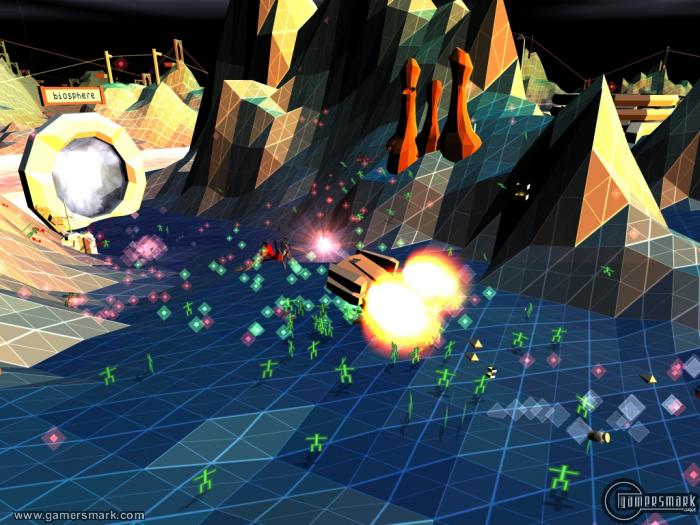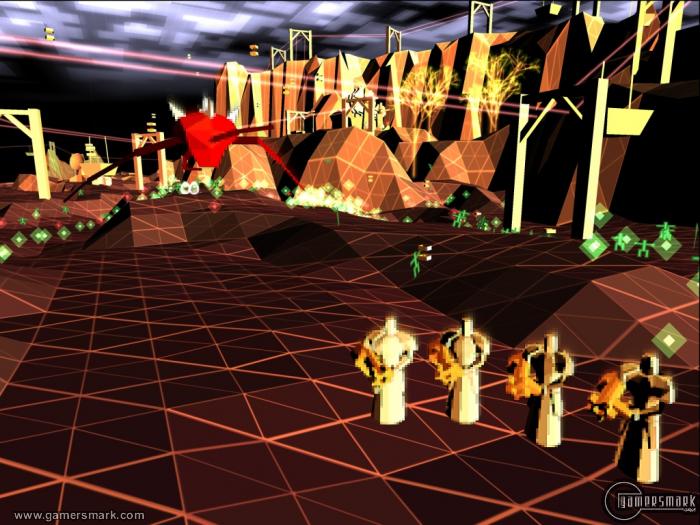Developer/Publisher: Introversion Studios || Overall: 9.2/10
It’s not too often that I play an innovative game on the PC. Especially since all the once-innovative games on PC have become old news. This has all changed with Introversion Software’s Darwinia. There isn’t one recently released game that I could name that has achieved the heights of innovation Darwinia has bestowed upon me and others who were fortunate enough to have played it already. In a presentation style that will remind everyone of a “retro” gaming look, you are immersed in a world of polygons and purposefully pixilated sprites, creating the feeling that you’re in a computer-generated world with a large amount of colors to bring it all to life; it’s a completely different approach to the recent trend of being as realistic as possible. Darwinia is made to look like a game. It’s truly a refreshing experience, not to mention it’s also fun.
Currently only released in the UK, Darwinia takes place in a world created by Dr. Sepulveda in which little green inhabitants called Darwinians live in communities, passing down their information into later generations. Dr. Sepulveda has managed to create tens of thousands of generations of Darwinians, allowing them to, in effect, evolve. But all is not well in Darwinia when a virus infects Darwinia, severely decreasing the population of Darwinians to drastic lows. The virus, in the form of bugs, must be exterminated to ensure the survival of Darwinia and its inhabitants. That’s where you come in. Not exactly sure why you’re there in the first place, Dr. Sepulveda asks you to help him as long as you’re there. Since the world of Darwinia is a computer, you’re given many computer-related techniques and weaponry to stop the virus and repopulate the Darwinians from utter extinction. Though the story is sparse, it works well enough to keep you going through the game.
While it is technically classified as a real-time strategy (RTS) game, Darwinia is far from the traditional RTS games you’ll encounter. First of all there is no resource gathering to build troops. You build all of your units (called “programs”) by going into a “task manager” and drawing “gestures.” There is no limit to how many you can make in the long run, but you can only have a limited amount of these programs running at the same time. Two of these important programs include the Squad and the Engineer, which will be used throughout the game. The Squad is your basic unit which allows you to clear out the viruses from Darwinia. Once the individual virus bugs are destroyed, you send in Engineers to gather up “souls” to bring back to an Incubator to give birth to Darwinians out of the information acquired. Engineers also allow you to take control of buildings you previously did not have control of before. As you progress through the game, all of your abilities will get better as Dr. Sepulveda researches/codes better things to do into the already existing programs. Later on your Squads can call in air-strikes, launch rockets and grenades, and your Engineers can gather more souls at the same time to bring back to the Incubator. The technology upgrading aspect is not new to RTS games, but you do not need to pool resources into making certain things better on account that there are no resources. You basically choose which technology to upgrade and play the waiting game. To utilize the different weaponry affinities your Squad can have, you must first have a squad selected on the map, and according to how to draw which kind of weaponry you want them to have, you can give them one of the more advanced abilities to use instead of the default grenades by drawing a gesture in the task manager.
Not only is what you see a throwback into what seems like 1980s-quality graphics in 3D, but you also get to enjoy an electronic-oriented soundtrack with an 8-bit-era flare to it. That’s when the music plays, though, because most of the time you’ll just be listening to the sound effects during the game. The main reason why they did this was probably because you’d be playing levels for a couple hours, and you’d listen to the same track over and over again.
What is unfortunate about the game is that the frame rate takes a dive once you begin going into huge levels with a massive amount of things happening at the same time. My computer well exceeded the recommended requirements to play the game, but I was still getting frame rates of less than ten or if I was lucky nearer to fifteen or twenty for a few seconds at a time. The latest patch available at the time (v1.21) didn’t help to remedy the problem either. This leaves to speculation whether or not the huge levels in the game should have been broken down into smaller stages or certain areas on the map were loaded at any given time rather than the whole map being displayed in real time. Even after putting all the graphics and sound options on their bare minimum and increasing the priority of the task in the Windows Task Manager to “Realtime” I still couldn’t hit the 30+ fps that was achieved in the very early stages of the game. The loss of frame rate impairs the way the game is played, making everything’s difficulty (even a simple click) ten times harder to do.
Just as a side note, if you have the Windows PowerToy that replaces your Alt+Tab switcher (like I do) to one that has a little screenshot of the program you want to switch to, you’ll have to disable it if you want to play Darwinia correctly, since it makes use of the Alt+Tab combination within the game and the PowerToy just messes it up. If you want to disable the PowerToy, you have to run “msconfig” from the “Run” dialog and uncheck the program called “taskswitch.exe.” This will disable the Alt+Tab PowerToy, and you can go back into it at a later time and re-enable it if you so desire. While using the keyboard combination in the first place is questionable to me, to say the least, there’s no way to change it, so you’ll have to adapt to it.
In the end, Darwinia really just is Lemmings on a grander scale. You have to use the Darwinians (which are more or less in a limited supply depending on how many souls you can get to incubate before they fly away after a certain amount of time) to complete certain objectives, and while you can use the programs at your disposal to complete the game, it really comes down to the managing of the Darwinians. If the Nintendo DS were powerful enough, Darwinia would be an almost-perfect game to make use of its touch screen.
I can’t stress this enough: Darwinia is an awesome game not only for the presentation alone, but also how unique the game is on its own. Hopefully developers/publishers will take Darwinia as an example and create games that go in a completely different direction from what is popular now and still make it an excellent game.



